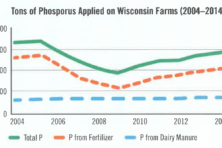Water Use Declined in 2013
- Share
- Tweet
- Pin
- Share
Wisconsin’s use of surface and groundwater declined six percent in 2013 from prior year levels as cooler temperatures and a return to normal rainfall patterns reduced demand for power plant cooling water, municipal drinking water and irrigation.
The details are featured in the 2013 Wisconsin Water Use Withdrawal Summary (dnr.wi.gov/topic/WaterUse/documents/WithdrawalReportSummary.pdf), a report that highlights the ways in which Wisconsin’s waters contribute to the state’s quality of life while powering the economy. The Wisconsin Department of Natural Resources prepares the report as part of its role to monitor and protect the state’s groundwater and surface water resources.
“Power generation continues to account for about 74 percent of Wisconsin’s water use, so when cooler temperatures returned in 2013, demand for cooling water from Wisconsin power plants dropped as well. This contributed to an overall reduction of power plant withdrawals in 2013 by about four percent,” said Bob Smail, DNR water supply specialist. “Municipal public water withdrawals represent the second largest category, accounting for about eight percent of overall use. Municipal water withdrawals also declined in 2013, falling by nearly 12 percent.”
Agricultural irrigation, the third largest category, accounts for about five percent of the state’s total water use and those levels declined by about 25 percent during 2013. This contributed to significant reductions of groundwater withdrawals in Portage, Waushara and Adams counties.
For 2013, water withdrawals from all surface and groundwater sources were at a three-year low of 2.12 trillion gallons. This was down from 2.25 trillion gallons in 2012 and 2.16 trillion gallons in 2011. Other categories contributing to the decreased use of water included golf course irrigation, down 39 percent; cranberry production, down 15 percent; and aquaculture, down nine percent.
“Water is an invaluable resource to nearly every aspect of Wisconsin’s environment, culture and economy. By continuing to track the locations, size and use of water withdrawals, we are ensuring that water management in Wisconsin is based on the best data available,” Smail said.


